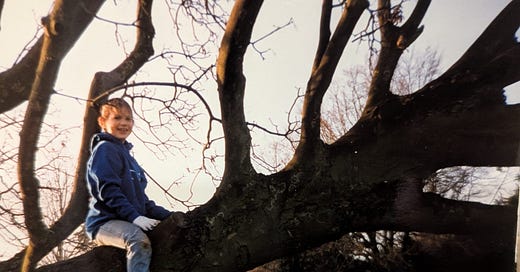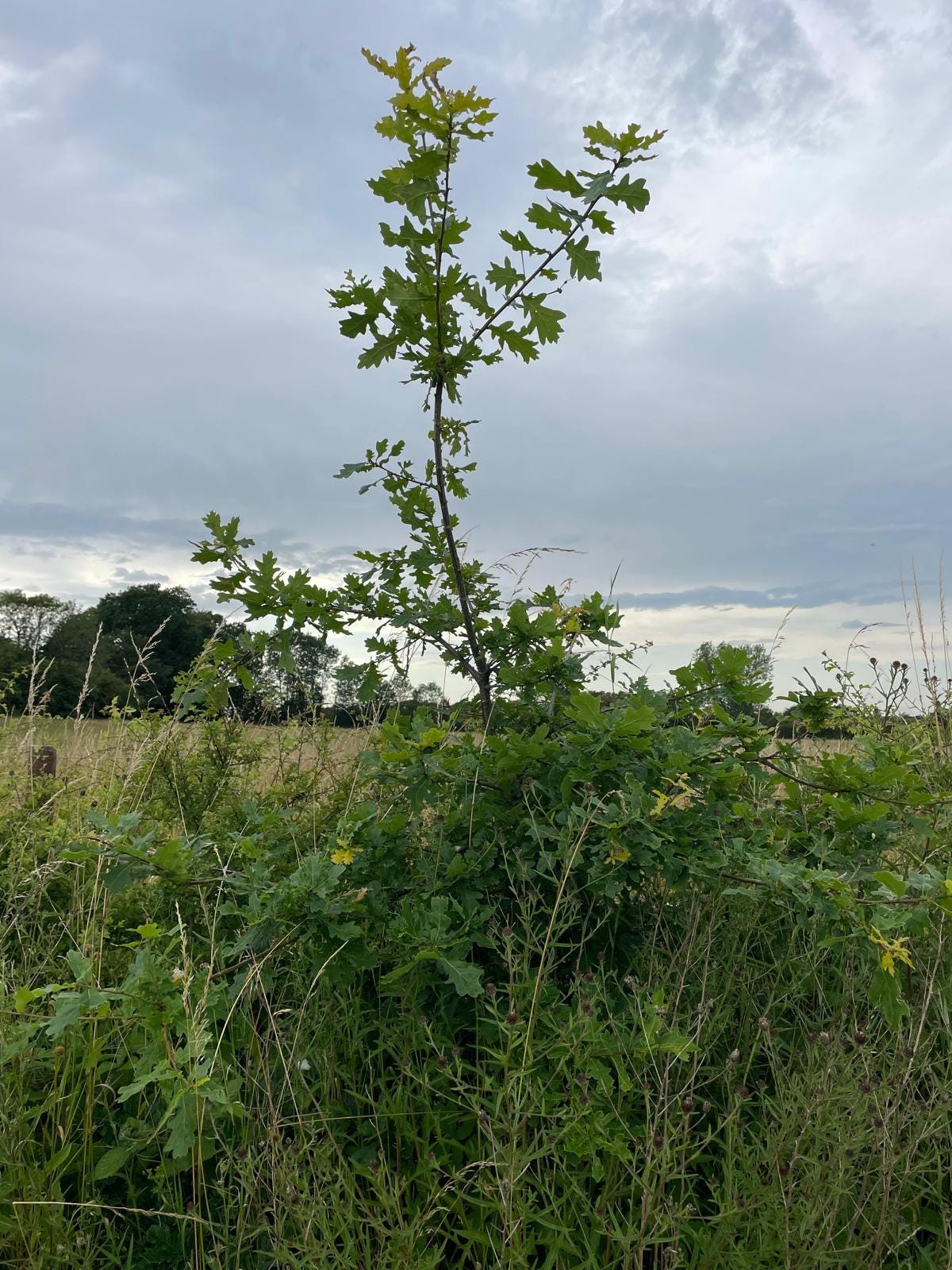A childhood friend of mine once fell out of a tree at the bottom of my grandparent’s garden. The tree had a fat bough that grew long and low and helpfully close to a grassed-over mound, which meant that making a plaything of it was easy. It was big enough for my sisters and I to suspend old wooden chicken crates from on it - lashing them tight with the orange bailer twine which could always be scavenged from somewhere - to make a camp. We were always in the market for new camps.
My friend was the daughter of neighbouring farmers. I saw her only in the holidays and, after she fell out of the tree, I don’t remember seeing her again, a fact I now imagine was probably related. Our memories are unreliable, but mine says she broke her arm. I remember seeing her fall but not much else except feeling two things: a total lack of fear that the same would ever happen to me and a sense that, somehow, I decided there were some people born to climb trees and some not. I, as you may guess, identified as the former.
Now I see it in my eldest son, that climbing confidence. I see it when he weighs up a fat truck with low slung boughs - ‘there’s a good climbing tree, Mamma’ - or treads light-footed over rocks on holiday to find shallow pools with secret creature hiding in them.
I’ve come lately to believe that my childhood self was wrong. I think that, given half a chance, we are probably all tree people. It is an old connection, this one between people and trees, but I’ve noticed something happening in the zeitgeist recently that has given voice to it in art, and books and news stories.
In Norse mythology, Yggdrasil is a giant ash tree that connects the Nine Worlds including Asgard (realm of the gods), Midgard (realm of humans), and Niflheim (underworld).
Maybe it is because new science has meant we finally understand a little better the magic that takes place underground which means we now know how trees communicate with each other. We know that a mother tree will send its saplings extra water and nutrients through an underground fungal network that experts like Merlin Sheldrake have called the Wood-Wide-Web, which explains why jay-planted* saplings dug up from the meadow and replanted in the new hedgerows grew feet taller than the orphan saplings (I can’t really think of tree saplings any other way now) planted there the year before.
We know they can warn each other of dangers, and even show a form of memory, adjusting their behaviour based on past experiences.
I have been thinking a lot recently about our relationship with trees and how this strange and tender connection finds an expression in art, poetry and literature. Bodies of words have tried to capture what trees mean to us. They are holders of family stories in Richard Power’s 2018 bestseller, The Overstory (apparently being adapted by the Game of Thrones guys for Netflicks); places to see a city anew – as described by Suffolk friend Jack Cooke’s The Tree Climbers Guide; or for the poet, William Blake, they became imagination itself (there’s quite a cool essay riffing on the idea here).
Books like The Hidden Life of Trees: What They Feel, How They Communicate by Peter Wohlleben explain that trees even have their own kind a kind of heartbeat, so that maybe pressing your ear to one with your arms around it and being convinced you can hear its aliveness may not be as wild as people thought.
Mostly though, I have been wondering if this new voice given to our love of trees has come about because of our loss of them. Trees we have loved and lost is the subject of a new exhibition by artist and friend, Nancy Cadogan, which I recently wrote about for The Financial Times here. The Lost Trees opens at The Garden Museum on 10th June to 20th July, as an arboreal memorial of individual trees: some well known enough to be named, some not. Standing in her studio surrounded by giant canvasses filled with paintings of great trees and her confirming that yes, all of them have been cut down, is a profound experience.
In my book Rooted I wrote a little about watching an old cinefilm of my grandmother when she was young and realising what was so different about the landscape behind her.
The fields and hedges and skyline around her looked both familiar and also strange, and I realized it was because of the trees – inconceivably tall and full – which lined the edges of the field alongside the fat hedges. The shape of them made the landscape seem somehow foreign. I watched my dead grandmother walk unthinkingly into a field filled with a horizon of trees that I have never seen and could not name. They must have been so commonplace to her that she surely believed they would be there forever, for elms were once an emblem of England, native descendants of the wildwood that covered much of the country 8,000 years ago. They were able to grow hundreds of feet high and twice as old in years, with a canopy that could stretch over a quarter of an acre. Because of this, they were often planted to mark the way on old country paths as they grew into a living road sign, tall enough to be seen above mist.
The cinefilm of my grandmother was taken around twenty years after Dutch elm disease first appeared in the United Kingdom in the 1920s. Since then over 25 million elm trees, 95 per cent of all mature elms in the United Kingdom, have been destroyed.
I never got to show you the film so thought you might like to see it for yourself now.
Two weekends ago I was on a panel at the Well Read Festival at the very special Wasing Estate. We were talking about the Sycamore Gap Tree when the chair, writer and journalist, Henry Mance, asked people to put up their hand if a tree they loved had been cut down. About a third of the audience did so. It was a stark thing to see from the vantage of the stage.
I’ve started to wonder if our feelings about lost trees come not only from a frustration at the sense of waste or shock that a tree surviving centuries had been felled in an hour in the name of progress. I wonder if its loss triggers something of our own mortality. As though by having picnics in a tree’s shade, or standing with our arms outstretched and our heart in our mouths as our kids climb up its branches, or falling half-asleep in its shade in mid-summer, or leaning against its bough in states of love and grief, we leave something of ourselves in them. It is impossible to walk beneath tree hundreds of years in their growing and not think of the other long-dead unknown people who performed the same rituals we do, and so we form some kind of bond with them too, our stories held in the trunk of a silent giant.
So maybe when we lose a tree we love we feel like we have lost a part of ourselves and our memories with it. Maybe now there are so few trees left to hold them, that their loss is more noticeable than it once was. And so now we are finding ways - in poetry and words and paint - to both express this and try and stop it happening.
*Jays - the jazzier cousins of magpies - can reportedly bury up to 5000 acorns a season, many of which grow into trees. According to this Guardian piece were responsible for more than half the trees planted in two new woodlands.
More Tree Stuff
I was sent a beautiful new book called Tree Hunting by Paul Wood (no I’m not kidding and if that’s not pre-nominative determinism in action I don’t know what is). He is the author of London’s Street Trees: A Field Guide to the Urban Forest and London Tree Walks. He also created The Great Trees of London Map too, which showcases 46 iconic London trees for you all to go and hug.
On 1st July I’ll be heading to Kew Gardens for their summer party which is, this year, focused around their new immersive installation Of the Oak, by experiential artist collective Marshmallow Laser Feast, which creates new art out of the inner workings of the Lucombe oak at Kew Gardens. There are guided meditations to synchronise your breath with the rhythm of the trees which are worth putting down the free cocktails for. It’s on now until 28th September.
I loved this piece in the Financial Times by Sarah Neville about the work of Dose of Nature, which came out on the same date as my own article about estates going from weddings into wellness. Both look at the growing body of science behind forest bathing (which, incidentally, has been standard in Japanese heath care since the 1980s) and how the data behind it shows why it should be taken more seriously as an alternative to pills by a cash-strapped NHS.
Read Robert Macfarlane’s 2016 New Yorker piece about Merlin Sheldrake, his work on ‘the social network of plants’, and what he was discovering (then set down in his 2021 bestselling book ‘Entangled Life’ and in his film Fungi: Web of Life. I saw it in with my mate Ollie - who, as you can see, even looks hot in 3D glasses - in a screening which was an instant sell out which, in central London, tells you a lot really). It’s worth a read for both Mcfarlane’s writing and unexpected stuff like the fact that you can, apparently, get funding as a young American scientist to collect urine from monkeys who have eaten fermented fruit in order to see whether or not they got drunk on it (read it here).
Within a previous substack I wrote about Kew Gardens there was a little about the Turner Oak, which linked an unforgettable short film about what trees taught Tony Kirkham, head of the Arboretum at Kew Gardens, which makes me cry each time I watch it.
There’s a good Guardian long read which offers a dissenting view. I’m not sure it’s really as sceptical as the headlines suggests but does offer up this cracking line to explain why trees are having a moment:
‘The wood-wide web narrative, Nixon believes, transcends science. Beyond the peer-reviewed research, there is something about the concept that, to many, just feels instinctively right. It gives us the trees for our times: anti-capitalist, feminist and extremely online.’










The only person I know who can pull off 3D glasses - smoking! Beautiful piece on one of my fave topics! Just spend weekend in Ebrington admiring my favourites there - the walnut trees - have exactly the kind of boughs you and WG would like. x
My hand would've raised at Wasing too. My friend Alison Crowther makes the most phenomenally beautiful sculptures from oak (mostly) which has fallen naturally. Her book has just published and it has a shot I took on the cover. One for the tree people, for sure.